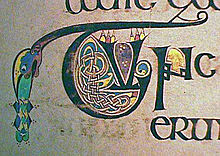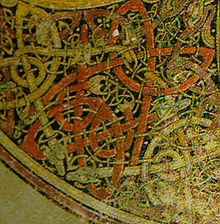|
Celtic Knotwork version from October 12, 2012 here's an outline of using traditional oscillations to make Celtic knotwork by traditional methods: and making music from it this is one of the simplest knots Step 1 start with equally spaced dots
which sounds like this
Step 2 is to draw a wave between every two points
repeat this for each pair of two points: since you can send the wave in two directions, up or down, on each point there are a total of four waves
which sounds like this
Step 3 is to cut these threads where you like: in this case I cut them on every fourth crossing point: and then tie those cut ends to their neighbor
which sounds like this
Step 4 is to follow each strand: each one, when it crosses should go under a strand it crosses, then over the next strand, then under the next, then over the next... (sometimes you have to deviate: I did this with three strands) and increase the width of the strands as desired
Step 5 is to remove the guides: this may be the simplest knot of this kind, but used in artwork
so the entire construction of this knot sounds like this: Construction of a simple Celtic Knot #1 here is the score, for any collection of instruments GOALS: 1. make an "app" with a good software writer
that will allow people to learn this artistic tradition, and
play the music As a guide, I am using a classic book by George Bain, Celtic Art: The Methods of Construction, that was used to teach Irish and Scots schoolchildren to make these patterns. Also note there is already a pretty good Celtic Knot design free program on the web at http://hypatiasoft.pagesperso-orange.fr/ we can use it as a basis, but add the ability to play music during the design, and make it more didactic. It will be a way to learn both the method of a traditional design based on oscillations (the patterns were meant to reflect the continuity of life and spirit, and probably came to the Celts from Asia and the Middle East) and explore making a music based on oscillations.
2. A live concert, that should also be recorded and shown as part of the display, in which local musicians, both traditional and classical, follow an artist's live construction of the drawings projected as a score while the steps are made to make these designs.
|
HWeJerere
Here








